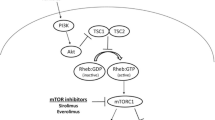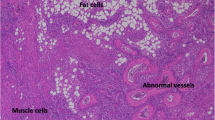Abstract
In patients with tuberous sclerosis complex (TSC), renal complications are not limited to bleeding angiomyolipoma (AML); although rare, end-stage renal disease (ESRD) may occur. New treatments (e.g., mammalian target of rapamycin (m-Tor) inhibitors) for AML might influence the epidemiology of ESRD in patients with TSC. In France, 99 patients with TSC from the Renal Epidemiology and Information Network (REIN) registry and having undergone renal replacement therapy (RRT) between 2002 and 2016 were included in the present study. Additional data were collected from the patients’ medical charts. The mean ± standard deviation age at RRT initiation was 48.4 ± 16.4 and 73.8% had a neurologic impairment. Fifty-four patients underwent kidney transplantation after an average of 23 ± 12.3 months on dialysis. Among the 61 patients with additional data the most common renal lesion was AML: 26.2% of the patients had isolated AML, and 26.2% had AML and renal cysts, 65.6% of patients had undergone nephrectomy, and 16.4% had undergone at least one embolization. None of the patients had been treated with an m-Tor inhibitor before dialysis. The graft survival rate was 92.5% at 5 years and 70.2% at 10 years. The present cohort study is the first to have assessed TSC patients on RRT from a national registry. Nephrectomy or embolization due to AML was the leading cause of ESRD in our cohort. By reducing the size of the AML, m-tor inhibitors might lower the risk of complications and thus reduce the number of patients with TSC requiring RRT.



Similar content being viewed by others
References
Jansen FE, van Nieuwenhuizen O, van Huffelen AC (2004) Tuberous sclerosis complex and its founders. J Neurol Neurosurg Psychiatry 75(5):770
van Slegtenhorst M, de Hoogt R, Hermans C, Nellist M, Janssen B, Verhoef S et al (1997) Identification of the tuberous sclerosis gene TSC1 on chromosome 9q34. Science 277(5327):805–808
Tee AR, Fingar DC, Manning BD, Kwiatkowski DJ, Cantley LC, Blenis J (2002) Tuberous sclerosis complex-1 and -2 gene products function together to inhibit mammalian target of rapamycin (mTOR)-mediated downstream signaling. Proc Natl Acad Sci USA 99(21):13571–13576
Budde K, Gaedeke J (2012) Tuberous sclerosis complex-associated angiomyolipomas: focus on mTOR inhibition. Am J Kidney Dis 59(2):276–283
O’Callaghan FJ, Shiell AW, Osborne JP, Martyn CN (1998) Prevalence of tuberous sclerosis estimated by capture–recapture analysis. Lancet Lond Engl 351(9114):1490
Osborne JP, Fryer A, Webb D (1991) Epidemiology of tuberous sclerosis. Ann N Y Acad Sci 615:125–127
Northrup H, Krueger DA, International Tuberous Sclerosis Complex Consensus Group (2013) Tuberous sclerosis complex diagnostic criteria update: recommendations of the 2012 international tuberous sclerosis complex consensus conference. Pediatr Neurol 49(4):243–254
Curatolo P, Bombardieri R, Jozwiak S (2008) Tuberous sclerosis. Lancet Lond Engl 372(9639):657–668
Samueli S, Abraham K, Dressler A, Groeppel G, Jonak C, Muehlebner A et al (2015) Tuberous sclerosis complex: new criteria for diagnostic work-up and management. Wien Klin Wochenschr 127(15–16):619–630
Shepherd CW, Gomez MR, Lie JT, Crowson CS (1991) Causes of death in patients with tuberous sclerosis. Mayo Clin Proc 66(8):792–796
Cook JA, Oliver K, Mueller RF, Sampson J (1996) A cross sectional study of renal involvement in tuberous sclerosis. J Med Genet 33(6):480–484
O’Callaghan FJ, Noakes MJ, Martyn CN, Osborne JP (2004) An epidemiological study of renal pathology in tuberous sclerosis complex. BJU Int 94(6):853–857
Rakowski SK, Winterkorn EB, Paul E, Steele DJR, Halpern EF, Thiele EA (2006) Renal manifestations of tuberous sclerosis complex: incidence, prognosis, and predictive factors. Kidney Int 70(10):1777–1782
Volpi A, Sala G, Lesma E, Labriola F, Righetti M, Alfano RM et al (2019) Tuberous sclerosis complex: new insights into clinical and therapeutic approach. J Nephrol 32(3):355–363. https://doi.org/10.1007/s40620-018-0547-6
Eijkemans MJC, van der Wal W, Reijnders LJ, Roes KCB, van Doorn-Khosrovani SBW, Pelletier C et al (2015) Long-term follow-up assessing renal angiomyolipoma treatment patterns, morbidity, and mortality: an observational study in tuberous sclerosis complex patients in the Netherlands. Am J Kidney Dis 66(4):638–645
Bissler JJ, Kingswood JC, Radzikowska E, Zonnenberg BA, Belousova E, Frost MD et al (2017) Everolimus long-term use in patients with tuberous sclerosis complex: four-year update of the EXIST-2 study. PLoS ONE 12(8):e0180939
Schillinger F, Montagnac R (1996) Chronic renal failure and its treatment in tuberous sclerosis. Nephrol Dial Transplant 11(3):481–485
Clarke A, Hancock E, Kingswood C, Osborne JP (1999) End-stage renal failure in adults with the tuberous sclerosis complex. Nephrol Dial Transplant 14(4):988–991
Lassalle M, Monnet E, Ayav C, Hogan J, Moranne O, Couchoud C (2019) 2017 Annual report digest of the renal epidemiology information network (REIN) registry. Transpl Int 32(9):892–902. https://doi.org/10.1111/tri.13466
Couchoud C, Stengel B, Landais P, Aldigier J-C, de Cornelissen F, Dabot C et al (2006) The renal epidemiology and information network (REIN): a new registry for end-stage renal disease in France. Nephrol Dial Transplant 21(2):411–418
Le rapport annuel REIN 2016—Agence de la biomédecine. (2018). https://www.agence-biomedecine.fr/rapport-annuel-REIN-2016. Accessed 11 Mar 2019
Kingswood JC, Bruzzi P, Curatolo P, de Vries PJ, Fladrowski C, Hertzberg C et al (2014) TOSCA—first international registry to address knowledge gaps in the natural history and management of tuberous sclerosis complex. Orphanet J Rare Dis 26(9):182
Krueger DA, Northrup H, International Tuberous Sclerosis Complex Consensus Group (2013) Tuberous sclerosis complex surveillance and management: recommendations of the 2012 international tuberous sclerosis complex consensus conference. Pediatr Neurol 49(4):255–265
Davies M, Saxena A, Kingswood JC (2017) Management of everolimus-associated adverse events in patients with tuberous sclerosis complex: a practical guide. Orphanet J Rare Dis 12(1):35
Bissler JJ, Budde K, Sauter M, Franz DN, Zonnenberg BA, Frost MD et al (2018) Effect of everolimus on renal function in patients with tuberous sclerosis complex: evidence from EXIST-1 and EXIST-2. Nephrol Dial Transplant 34:1000–1008
Kingswood JC, Belousova E, Benedik MP, Carter T, Cottin V, Curatolo P et al (2019) Renal angiomyolipoma in patients with tuberous sclerosis complex: findings from the TuberOus SClerosis registry to increase disease awareness. Nephrol Dial Transplant 34(3):502–508
Okada RD, Platt MA, Fleishman J (1982) Chronic renal failure in patients with tuberous sclerosis. Assoc Renal Cysts Nephron 30(1):85–88
Bernstein J, Robbins TO, Kissane JM (1986) The renal lesions of tuberous sclerosis. Semin Diagn Pathol 3(2):97–105
Acknowledgements
This study was funded by Agence de la Biomédecine. To all the participating centers.
Author information
Authors and Affiliations
Corresponding author
Ethics declarations
Conflict of interest
The authors have no conflict of interest.
Ethical approval
Data collection by the REIN registry had been approved by the French national data protection commission (Commission nationale de l'informatique et des libertés, CNIL (Paris, France); reference: 903188). The present study was approved by the REIN registry’s Scientific Advisory Board.
Additional information
Publisher's Note
Springer Nature remains neutral with regard to jurisdictional claims in published maps and institutional affiliations.
Rights and permissions
About this article
Cite this article
Vabret, E., Couchoud, C., Lassalle, M. et al. From tuberous sclerosis complex to end stage renal disease: who are these patients?. J Nephrol 34, 607–615 (2021). https://doi.org/10.1007/s40620-020-00714-3
Received:
Accepted:
Published:
Issue Date:
DOI: https://doi.org/10.1007/s40620-020-00714-3




